Robert Mitchum’s Summer Under The Stars Celebration–The One and Only Noir Cowboy

Blood on the Moon
Where a woman’s bullet kills as quick as a man’s!
When there’s blood on the moon, death lurks in the shadows….
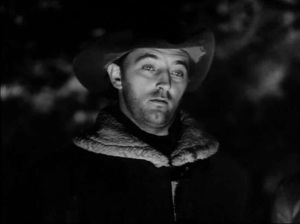
Tomorrow, Robert Mitchum is honored with a Summer Under The Stars Celebration, and in light of the Summer of Darkness highlighting film noir and the popular online film noir course taught by Professor Richard Edwards of Ball State University, I am happy that TCM is airing 1948’s Blood on the Moon.
Shot outside of Sedona, Arizona, and directed by Robert Wise (1914-2005), a director most well-known for his nurturing of the Von Trapp Family Singers in The Sound of Music in 1965, Blood on the Moon would be part of the Western genre that Wise was completely unfamiliar with in his directorial career. Based on Luke Short’s 1941 novel, Gunman’s Chance, Blood on the Moon tested Wise’s unfamiliarity with the Western genre, and his lack of passion for it, but it may have proven an asset to the film’s success. Since this was Wise’s first A-budget film, he was obviously concerned that all would go well, and the weather proved to create some problems in Sedona, but Wise claimed that “we tracked the weather like we were at NASA at a rocket launching” receiving three different weather reports each day, and the crew would often follow the good weather through the valley. Wise’s dedication would pay off.
According to author David Meuel in The Noir Western: Darkness on the Range, 1943-1962, “While Wise was respectful of the genre’s traditions and conventions, he wasn’t married to them. He felt obliged to be true to the spirit of the western, but he also felt free enough to infuse this film with some of the elements of the norror and noir films he had recently done for RDO and which the studio (later nicknamed the “House of Noir) specialized in.”
A minor Out of the Past regrouping would see Mitchum and cinematographer Nicholas Musaraca using their creativity to infuse the Western with Robert Wise’s “craftsman’s soul,” according to Mitchum biographer Lee Server. “Synthesizing techniques he had gleaned from his two creative mentors, Val Lewton and Orson Welles, Wise set out to make Blood on the Moon a studied, uniquely atmospheric Western.”
Meuel credits some of Blood on the Moon‘s success to “Robert Mitchum, an actor whose ability fo convey emotional complexity ad moral ambiguity made hin a noir icon and whose work her is as intriguing as his work in any of his oir crime films.”
The character of Jim Garry was just one more of Mitchum’s “outsider roles” by Server’s accounts, and “a solitary gunfighter-for-hire with a conscience, a script’s mysterious stranger about to be made even more msterious by the actor’s enigmatic style.” The other cast members rounded up for the location shoot included “architect Norman Bel Geddes’ refined young daughter, Barbara” (eventually ‘Miss Ellie’ on the primetime saga, Dallas), who had been “recently signed to a long-term contract; Robert Preston, playing his patented role of the corrupt best friend,” and “Walter Brennan as a grizzled homesteader.”
The film’s costumer, selected by Wise, was Joe De Young, a man who worked for Howard Hawks in Red River, and was a “specialist in Western attire.” According to Server, “De Young came up with the authentic but idiosyncratic, sometimes bizarre outfits (bearskin and gaudy plaid cots, derby hats) that would give the film another of its distinctive qualities.”
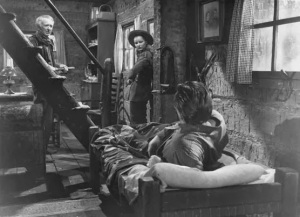
When Mitchum strolled and strutted on the set ” in beard, greasy hair, high-domed Steson, and chaps” appeared to be “anything but the conventional well-groomed, respectable Western hero.” Server’s biography revealed that director Wise claimed “the first scene we shot after Mitch got outfitted was in the barroom. Walter Brennan was sitting at a table with a couple of pals, and Brennand was very intrested in the Old West, it was a hobby of his. And I’ll never forget when Bob came on the set, just standing there, wth the costume and the whle attitude that he gave to it, and Brennan got a look at him and was terribly impressed. He pointed at Mitchum and said, ‘That is the goddamndest realest cowboy I’ve ever seen!”
Meuel claims that the term “the noir western” is very “oxymoronic. On one hand, we have the bright, expansive, colorful landscapes; upright heroes; and nation-building exuberance we associate with most film westerns. On the other, we have the dark, claustrophobic, black-and-white (mostly black) cityscapes; flawed, compromised heroes; and bitter disillusionment of the classic noir crime dramas of the 1940s and 1950s.” It may be called a “sub-genre” but it also might be a “budding film form” in its own right. But Meuel also reveals that “the ‘Wild West’ of the movies was a darker, moodier, more complicated place” after World War II.
Nicholas Chennault’s synopsis, sums up the action concerning Blood on the Moon:
“Jim Garry (Robert Mitchum) is drifting from Texas, when he’s invited by old friend Tate Riling (Robert Preston, in his sleazy friend mode) to join him in a get-rich-quick scheme with corrupt Indian agent Jake Pindalest (Frank Faylen).

John Lufton (Tom Tully) is the local cattle baron, who has long provided beef for the reservation while grazing his herds on reservation land. Pindalest, on Riling’s urging, has given Lufton notice that he’ll no longer be buying Lufton’s beef, and Lufton has to find new grazing land. He’s trying to move his cattle back to the basin where he used to graze, but now there are homesteaders there to resist, led by Riling. Kris Barden (Walter Brennan), who used to work for Lufton, is prominent among them.
Lufton has two daughters, one of whom, Carol (Phyllis Thaxter), is romantically interested in Riling and the other, Amy (Barbara Bel Geddes), takes a few shots at Garry. After being fully informed of the set-up and participating in stampeding Lufton’s herd, Garry decides the scheme isn’t for him and saves Lufton from two of Riling’s gunmen. He’s hurt in a fight with Riling but gets Pindalest to tell the army to back off on the deadline for removing Lufton’s herd.
SPOILER ALERT
Riling, Pindalest and a couple of gunmen come after Garry, who’s wounded and holed up at Barden’s place. Amy Lufton shows up to give medical care and to help fight off the bad guys. (You can tell Riling’s sleazy because of the loud, plaid jacket he wears.) In the end Garry kills one of the gunmen, shoots it out with Riling, and gets Amy.”
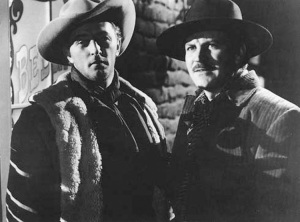
The fistfights were real. Server revealed that director Wise wanted both Mitchum and Preston to do their own stunts and the principal actors both agreed. They had both become fast friends on the set and spent a lot of time “getting under the skin of the girls, played by Bel Geddes and Phyllis Thaxter.

“I wanted this to look like a real fight,” Wise said. He wanted it to have that “awkward, brutal look of a real fight, and when it was done for the winner to look as exhausted as the loser. And Mitch was excited about this. He knew exactly what I was going for. I think he probably knew more than I did about barroom fights like this one.” So the actors crashed around on the set for three days to orchestrate the film’s most realistic sequence. ” As for his work with Mitchum, Wise added that “Bob was just fine to work with” and that “he liked this part and he contributed a number of ideas… He never wanted to do too much. Just enough and then hold back a little, leave something a little unspecified. He was very bright, very facile, quick with language. But he likes to give the impression that he somehow wasn’t articulate.”
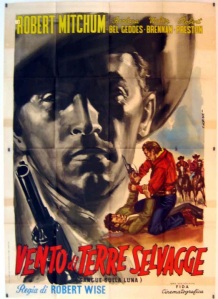
If you want to enjoy Mitchum as one of the first noir cowboys directed by the genius of Robert Wise and photographed by the talented Nicholas Musaraca, your opportunity starts Wednesday at 12:30 central on TCM.
This post was created as part of the Summer Under The Stars Blogathon sponsored by Kristen Lopez and Journeys in Classic Film.
Resources:
David Meuel, The Noir Western: Darkness on the Range, 1943-1962, McFarland & Company, Inc., Jefferson, North Carolina, 2015.
Lee Server, Robert Mitchum, “Baby, I Don’t Care.” St. Martin’s Press, New York. 2001.
http://www.amazon.com/Robert-Mitchum-Baby-Dont-Care/dp/0312285434
Nicholas Chennault, http://thegreatwesternmovies.com/2014/01/18/blood-moon/
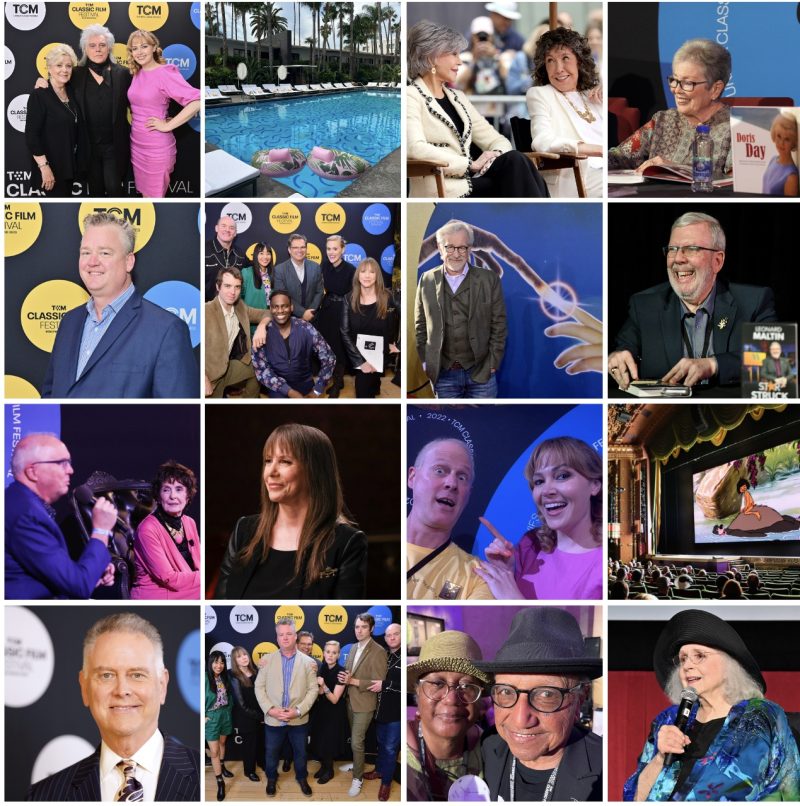

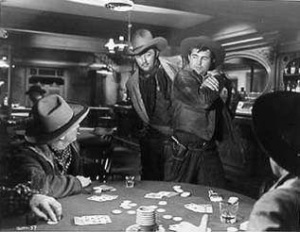
Great! I was planning on investigating Mitchum’s filmography this winter. I loved this article you did of him in the Western genre. Thank you 🙂
Thank you, Cindy! I enjoyed writing it. I can’t wait for tomorrow’s screenings. Mitchum is one of my favorites.
Pingback: Summer Under the Stars Blogathon: Day 12 – Robert Mitchum |
Reblogged this on Losh-Man's Hollywood Classics and commented:
Christy Putnam was a regular guest on a radio show I did a couple years ago by the same name as my blog and was always a joy to chat with.This is being shared here on Losh-Man’s Hollywood Classics with her expressed permission. I know you will enjoy her work as much as I do!
Thanks, John!